Upon the release of the second-generation AirPods Pro, the AirPods Max became the oldest current-generation AirPods product still in Apple's lineup. Introducing several new features like Adaptive Transparency and the H2 chip, the second-generation AirPods Pro may provide some of the best indications yet of what to expect from the second-generation AirPods Max.

Almost two years later, rumors about a successor to the original AirPods Max are thin on the ground. The last we heard about the next-generation AirPods Max was a report from Bloomberg's Mark Gurman in May 2021, which explained that Apple was considering launching new color options for the device. In addition to new color options and revised audio hardware, there are at least ten potential AirPods Pro features that could make their way to the second version of the AirPods Max.
H2 Chips
The second-generation AirPods Pro are the first device to contain the H2 chip, Apple's custom silicon chip designed specifically for earbuds and headphones.

The H2 chip enables improved computational audio to enhance sound quality on the AirPods Pro and improves battery life with better energy efficiency. As the AirPods Max are Apple's most high-end AirPods, it seems almost certain that the next version will contain an H2 chip in each earcup. The chips will likely be at the heart of any improvements to the device's audio hardware.
Bluetooth 5.3 Connectivity
Alongside the H2 chip, the new AirPods Pro feature Bluetooth 5.3, a specification that has also come to the entire iPhone 14 lineup as well as the Apple Watch SE, Apple Watch Series 8, and Apple Watch Ultra. As such, it is inevitable that the second-generation AirPods Max will similarly feature the latest Bluetooth standard. Bluetooth 5.3 offers features important enhancements to reliability, connection performance, and power consumption.
Improved Active Noise Cancellation
Thanks to the H2 chip, the second-generation AirPods Pro feature improved Active Noise Cancellation (ANC) that is up to two times more effective at blocking out unwanted noise.

The outward-facing microphones detect external sound so the AirPods can analyze environmental noise, while the inward-facing microphone listens to the sound coming toward the ear. The new AirPods Pro then adapts the sound signal reaching the ears 48,000 times per second to eliminate external noise.
The second-generation AirPods Pro are also equipped with a new driver and improved acoustic algorithms to reduce additional unwanted noise. As the only other AirPods to offer ANC, it seems inevitable that with the H2 chip, the second-generation AirPods Max will also offer enhanced ANC.
Adaptive Transparency
The second-generation AirPods Pro feature an all-new Adaptive Transparency mode that allows important environmental noise like speech in, while heavily reducing unwanted environmental noise like a passing vehicle siren, construction tools, or even loud speakers at a concert.

The feature is designed for "for more comfortable everyday listening," according to Apple. Along with improvements to ANC facilitated by the H2 chip, it seems highly likely that the second-generation AirPods Max will also feature Adaptive Transparency.
Conversation Boost
It is also possible that the AirPods Max could also gain Conversation Boost, a feature that has thus far been exclusive to the AirPods Pro.

Designed to help people with mild hearing challenges hear conversations better, Conversation Boost uses the beam-forming microphones on the AirPods Pro to boost the volume of a person talking directly in front of you, making it easier to hear what they are saying.
Skin-Detect Sensors
Apple's skin-detect sensor technology was first introduced on the third-generation AirPods and recently expanded to the AirPods Pro, leaving the AirPods Max as the only current-generation AirPods product without the feature. The current AirPods Max still use optical IR sensors to detect when they are placed over a user's ears.

While skin-detect sensors would not be quite as useful on the AirPods Max since playback is unlikely to be triggered on a surface or in a pocket, they could help playback pause and resume more quickly and accurately. The skin-detect sensors are also more efficient and deliver better battery life – something that the AirPods Max could also take advantage of.
Longer Battery Life
Apple touts improved battery life for both the third-generation AirPods and the second-generation AirPods Pro. The second-generation AirPods Max could gain a similar battery life boost using the efficiency gains of the H2 chip, Bluetooth 5.3, and skin-detect sensors, providing Apple does not shrink the size of the internal battery.
Sweat and Water Resistance
The third-generation AirPods and second-generation AirPods Pro feature IPX4-rated sweat and water resistant earbuds and charging cases. This is an area that Apple has improved over time on its various earbuds, but the first-generation AirPods Max do not feature any sweat or water resistance rating.

Some sort of sweat and water resistance rating for the second-generation model seems plausible, especially given Apple's growing focus on health and fitness. Apple Fitness+ launched just a day before the release of the first-generation AirPods Max in 2020, so it is not out of the question for the second-generation model to have more of a focus on fitness by being sweat-resistant.
U1 Chip and Precision Finding
The second-generation AirPods Pro's MagSafe Charging Case features an Apple U1 chip for Precision Finding in the Find My app, much like AirTag item trackers.

The current AirPods Max feature basic support for Find My, but a U1 chip in the second-generation version could enable a much more precise way to locate the headphones when they are nearby.
Charging
The second-generation AirPods Pro's case added the ability to charge using an Apple Watch charger, adding to the plethora of charging options that already included MagSafe, Qi wireless charging, and Lightning.

It is too early to say if the second-generation AirPods Max will feature a new way to charge, such as via MagSafe, but such a change would necessitate deeper changes to the AirPods Max's design. Nevertheless, the fact that Apple now provides four different ways to charge the AirPods Pro could indicate that it is aware of the benefits of multiple ways to charge and could want to expand this to its highest-end headphones in some way.























Top Rated Comments
“Every new feature that came to the second generation Pros will come to the second generation Max”.
Done. End of article.
I've been using one for the last 6 months. I've given away my Airpods Pro to my family because the Max is so much better for office work and general listening. I only miss it when I need something for workouts. Other than that, the Max is simply superior to the Pro.
Airpods Max got me laid once. I had a date with a hot audiophile girl who brought her expensive Sennheisers over to compare to the Max. She swears nothing can beat her Sennheisers in quality. After trying it on, she admitted that the Max sounded much better. This led me to getting laid that evening. Great time.